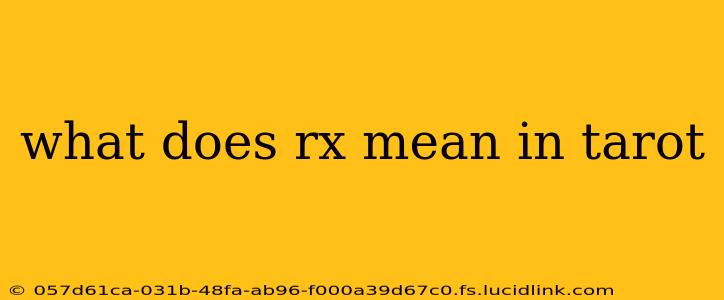The world of tarot can be captivating and complex, filled with symbolism and nuanced interpretations. One element that often confuses beginners is the "RX" designation you'll see alongside certain cards. This simply means reversed. But understanding what a reversed card signifies goes beyond a simple "opposite" meaning. Let's delve into the intricacies of reversed cards in tarot and how to interpret them.
What Does it Mean When a Tarot Card is Reversed?
In a tarot reading, a reversed card indicates a different energy than its upright counterpart. It doesn't necessarily mean the opposite, but rather a shadow aspect or a potential obstacle related to the card's core theme. Think of it like this: the upright card represents the ideal, the potential, while the reversed card highlights challenges, delays, or internal blocks preventing that ideal from manifesting.
It's important to note that not all tarot readers interpret reversed cards. Some prefer to focus solely on the upright meanings, finding sufficient depth and complexity in the upright positions alone. The decision to use reversed cards is entirely a matter of personal preference and reading style.
How to Interpret Reversed Tarot Cards
Interpreting reversed cards requires a nuanced approach. You shouldn't simply flip the upright meaning. Instead, consider these aspects:
- Internal Obstacles: Reversed cards often point to internal struggles or blocks hindering progress. For instance, a reversed Empress might suggest neglecting one's nurturing side or experiencing difficulties with fertility or abundance.
- External Challenges: They can also signify external challenges or obstacles that may arise. A reversed Tower, for example, might indicate unexpected disruptions or sudden upheavals in life.
- Delayed Manifestation: The desired outcome associated with the upright card might be delayed or obstructed.
- Shadow Aspects: Reversed cards can illuminate the shadow aspects of the card's theme – the less desirable qualities or potential pitfalls. A reversed Sun, for instance, might represent feelings of darkness or inner gloom, rather than the radiant joy typically associated with the upright card.
- Intensified Negativity (with caution): While not always the case, some readers interpret certain reversed cards as intensifying negative aspects of their upright meaning. This requires careful consideration and should be balanced with other cards in the spread.
Common Misconceptions About Reversed Cards
Let's address some common misconceptions surrounding reversed cards:
Myth: Reversed Cards Always Indicate Negativity
This is a significant misconception. While reversed cards often present challenges, they are not inherently negative. They offer valuable insights into potential obstacles or areas needing attention. They can be catalysts for growth and self-awareness.
Myth: Reversed Cards Are Automatically the Opposite of the Upright Meaning
This is an oversimplification. The meaning shifts, but it's not a direct inversion. Think of it as a different perspective or a shadowed version of the upright meaning, not a complete 180-degree turn.
Examples of Reversed Cards and Their Interpretations:
Let's look at a few examples to illustrate:
- The Lovers (Reversed): Instead of harmonious relationships, this could suggest conflict, disharmony, or indecision in relationships.
- The Wheel of Fortune (Reversed): This doesn't mean bad luck always; it could suggest unexpected delays or setbacks in the cyclical flow of life, requiring adaptation and patience.
- The Tower (Reversed): While the upright Tower represents sudden and disruptive change, the reversed Tower might signify resisting necessary change or avoiding confrontation, leading to stagnation.
Conclusion: Embracing the Nuances of Reversed Tarot Cards
Reversed cards in tarot offer a deeper layer of understanding, illuminating potential obstacles and shadow aspects. By understanding their nuances and avoiding common misconceptions, you can gain a more comprehensive and insightful interpretation of your tarot readings. Remember, practice and intuition play a crucial role in mastering the art of interpreting reversed cards. Embrace the complexity and allow the cards to guide you towards a richer understanding of yourself and the situations you're facing.
